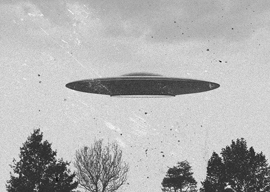
December 20, 2017

Source: Bigstock
All sorts of bizarre aircraft took to the air during this period. For example, Northrop’s B-2 stealth bomber’s flying wing design was not originated in the 1980s. Northrop had first test-flown its YB-35 flying wing bomber way back in 1946.
Johnson’s Skunk Works churned out improbable airplanes, such as in 1954 the Mach 2 F-104 with wings only seven feet long, in 1956 the spindly U-2 high-altitude spy plane, and in 1962 the Mach 3 A-12/SR-71 Blackbird.
The Blackbird was so radical in shape that for national-security reasons it couldn’t be flown from Lockheed Airport in Burbank to Area 51 (yes, it’s real) in Nevada. It had to be trucked in giant wrapped packages, guarded by CIA men with submachine guns. When the convoy accidentally dented a Greyhound bus, the CIA agents handed the bus driver a little under $5,000 in cash to get his vehicle repaired, no questions asked.
In 1963, when an A-12 crashed on its way back to Area 51, the crash site was immediately “sanitized.” Civilians who stumbled upon it were given a prearranged cover story that the crash was merely a run-of-the-mill F-105, but an F-105 carrying a nuclear bomb, so they had better head over the horizon fast. They were paid off in cash, perhaps $25,000 each, and informed never to speak of what they had seen.
In reading about UFOs, it sometimes seems like there’s a certain Jungian tendency for humans to project shapes they not only want to see but want to build onto whatever it is they saw. Carl Jung himself published an influential 1958 book, Flying Saucers: A Modern Myth of Things Seen in the Sky, arguing that UFOs were a collective projection of anxieties over nuclear war.
A more prosaic interpretation is that defense contractors tended to see what they hoped to get a contract to design.
For example, that day in 1953 that Kelly Johnson saw a flying saucer over the Pacific, a magazine article had been published on Avro’s R&D work on building a real flying saucer. Three years later, Lockheed added to that Constellation that had also observed Johnson’s UFO a new round radar dome (“rotodome”) mounted above the fuselage that, indeed, looked like a flying saucer.
Coincidence or synchronicity?
When the Skunk Works began working on its stealth fighter in the 1970s, early designs included a flying-saucer shape. Johnson’s successor Ben Rich laughed:
Several of our aerodynamics experts, including Dick Cantrell, seriously thought that maybe we would do better trying to build an actual flying saucer. The shape itself was the ultimate in low observability. The problem was finding ways to make a saucer fly. Unlike our plates, it would have to be rotated and spun. But how? The Martians wouldn’t tell us.
It’s also possible that besides reflecting the hopes and dreams of government contractors, flying-saucer mania reflected government disinformation.
The late science-fiction novelist Jerry Pournelle told me in 2000 that when the Soviets were testing their Fractional Orbit Bombardment System for outwitting the U.S. distant early warning system in the Arctic by attacking from the south, an occasional missile would come down over Latin America, embarrassingly. After the first accurate reports would come in from observers, according to Jerry, Soviet KGB agents in Spanish-speaking countries would flood newspapers with absurd accounts of little green men to discredit the accurate tales.
The 2013 documentary Mirage Men argued that the U.S. government had been up to much the same in the West. Rather than the government suppressing awareness of UFOs, perhaps the government promoted flying saucers to cloud public awareness of what it had stumbled upon in the interests of keeping accurate information out of the hands of the Russians?
For example, the Roswell incident was dismissed by the government as a mere weather balloon that crash-landed. In reality, it was part of the top secret Project Mogul: a high-tech strategic reconnaissance balloon made out of state-of-the-art synthetic substances that was supposed to float across the Soviet Union checking for atomic-bomb tests. When the UFO conspiracy theorists revived Roswell in the 1970s, perhaps the government found it useful to encourage flying-saucer paranoia?
In turn, the Soviets devoted much money to spying on Lockheed’s Skunk Works. A Soviet electronic warfare ship disguised as a fishing trawler was often stationed off Santa Monica to try to pick up radio signals from Burbank. Experimental aircraft on the runway at Lockheed had to be trundled back into hangars whenever Soviet reconnaissance satellites appeared overhead.
No doubt the Soviets also had local agents trying to learn more about what was flying out of Area 51. Soviet espionage had proved hugely effective at learning American secrets during the 1940s, using indigenous communists such as teenage atomic-bomb prodigy Ted Hall. But the McCarthy era disabled the Communist Party USA, so 1950s Soviet spymaster Rudolf Abel, as portrayed in the 2015 Spielberg movie Bridge of Spies, spent most of his time in New York painting.
If the U.S. government really did spread flying-saucer rumors to confuse witnesses out West, it was hugely successful. The stealth fighter, for instance, was apparently unknown to the Soviets from its Have Blue predecessor’s first flight at Area 51 in 1977 until the Pentagon announced its existence in 1980.
The stealth fighter, which bounced radar beams away, was so alien in form that it looked like it had been designed by one of those ETs they keep locked away at Area 51. Ironically, America’s strategically successful stealth program was based on a Soviet physicist’s equations. Yet the feds managed to keep the Soviets so distracted they never figured that out until it was too late for their empire.